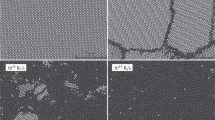Abstract
Theories based on the concepts of free volume and the existence of holes in liquids are briefly reviewed. Available experimental data on the changes in specific heat and thermal expansion at the glass transition temperature and the temperature dependence of viscosity near transition have been utilized to evaluate the hole formation energy and critical hole size in palladium-, platinum- and gold-based metallic glasses. It has been found that in conformity with theoretical predictions, transport in metallic glasses occurs by the movement of highly ionized atoms. A linear relationship exists between the hole formation energy and glass transition temperature of metallic glasses. It is suggested that a high energy of hole formation is a necessary criterion for easy vitrification of metallic melts. The behaviour of vacancies in crystalline metals is compared with the behaviour of holes in metallic glasses.
Similar content being viewed by others
References
M. H. Cohen andD. Turnbull,J. Chem. Phys. 31 (1959) 1164.
G. S. Cargill III,Solid State Physics 30 (1975) 227.
H. S. Chen andD. Turnbull,J. Chem. Phys. 48 (1968) 2560.
H. S. Chen,J. Non-Cryst. Solids 12 (1973) 333.
H. S. Chen andD. Turnbull,Acta Met. 17 (1969) 1021.
D. E. Polk andH. S. Chen,J. Non-Cryst. Solids 15 (1974) 165.
H. S. Chen, J. T. Krause andE. A. Sigety,ibid 13 (1973) 321.
H. S. Chen, J. T. Krause andE. Coleman,ibid 18 (1975) 157.
H. S. Chen andM. Goldstein,J. Appl. Phys. 43 (1972) 1642.
P. Ramachandrarao, B. Cantor andR. W. Cahn,J. Non-Cryst. Solids 24 (1977) 109.
S. Glasstone, K. J. Laidler andH. Eyring, “Theory of Rate Processes” (McGraw-Hill, New York, 1941) p. 477.
N. Hirai andH. Eyring,J. Appl. Phys. 29 (1958) 810.
Idem, J. Polymer Sci. 37 (1959) 51.
A. J. Batschinski,Z. Phys. Chem. 84 (1913) 644.
A. K. Doolittle,J. Appl. Phys. 22 (1951) 471.
A. K. Doolittle andD. B. Doolittle,J. Appl. Phys. 26 (1957) 901.
J. H. Hildebrand andR. L. Scott, “Regular Solutions” (Prentice-Hall, New Jersey, 1962), p. 60.
A. Bondi,J. Phys. Chem. 58 (1954) 929.
M. F. Williams, R. F. Landel andJ. D. Ferry,J. Amer. Chem. Soc. 77 (1955) 3701.
T. G. Fox andP. J. Flory,J. Appl. Phys. 21 (1951) 581.
F. Bueche,J. Chem. Phys. 30 (1959) 748.
D. Turnbull andM. H. Cohen,ibid 52 (1970) 3038.
R. N. Haward, in “Molecular Behaviour and the Development of Polymeric Materials”, edited by A. Ledwith and A. M. North (Chapman and Hall, London, 1975), p. 404.
D. Turnbull andB. G. Bagley, in “Treatise on Solid State Chemistry”, Vol. 5, edited by N. B. Hannay (Plenum Press, New York, 1975), p. 513.
B. G. Bagley, in “Amorphous and Liquid Semiconductors”, edited by J. Tauc (Plenum Press, New York, 1974), p. 1.
J. Frenkel, “Kinetic Theory of Liquids” (Dover Publications, New York, 1955), p. 93.
P. J. Flory, “Principles of Polymer Chemistry” (Cornell U.P., Ithaca, 1953)
J. Huggins,J. Phys. Chem. 52 (1948) 248.
J. H. Hildebrand,J. Chem. Phys. 15 (1947) 225.
I. Gutzow, in “Amorphous Materials”, edited by R. W. Douglas and B. Ellis (Wiley and Sons, London, 1971), p. 159.
Idem, Compt. Rend. Bulg. Acad. Sci. 29 (1976) 85.
D. Turnbull,J. de Physique 35 (1974) C1.
V. F. Ukhov, E. L. Dubinin, O. A. Esin andN. A. Vatolin,Russ. J. Phys. Chem. 42 (1968) 1391.
W. Merz andF. Sauerwald,Acta Met. 14 (1966) 1617.
F. Spaepen andD. Turnbull, in “Rapidly Quenched Metals” edited by N. J. Grant and B. C. Giessen (MIT Press, Cambridge, Massachusetts, 1976) p. 205.
Yu. S. Cherkiuskii,Sov. Phys-Dokl. 21 (1976) 55.
“Handbook of Chemistry and Physics”, edited by R. C. Weast (CRS Press, Cleveland, Ohio, 1975–76), p. 209.
C. J. Smithells, “Metals Reference Book” (Butterworths, London, 1967), p. 139.
H. S. Chen andE. Coleman,Appl. Phys. Letters 28 (1976) 245.
D. Gupta, K. N. Tu andK. W. Asai,Phys. Rev. Letters35 (1975) 380.
M. Cohen andD. Turnbull,Nature 189 (1961) 131.
C. H. Bennett, D. E. Polk andD. Turnbull,Acta Met. 19 (1971) 1295.
D. E. Polk,ibid 20 (1972) 485.
D. E. Polk,Scripta Met. 4 (1970) 117.
H. S. Chen andB. K. Park,Acta Met. 21 (1973) 395.
K. L. Chopra, “Thin Film Phenomena” (McGraw-Hill, New York, 1969) p. 195.
S. R. Nagel andJ. Tauc,Phys. Rev. Letters 35 (1975) 380.
D. R. Uhlmann,J. Non-Cryst. Solids 7 (1972) 337.
H. A. Davies,ibid 17 (1975) 266.
F. Spaepen andD. Turnbull, Paper presented at the American Society for Metals Seminar, Niagara Falls, 1976: to be published.
E. Fukushima andA. Ookawa,J. Phys. Soc. Japan 10 (1955) 970.
Ya. A. Kraftmakher andP. G. Strelkov, in “Vacancies and Interstitials in Metals”, edited by A. Seegeret al. (North-Holland, Ansterdam, 1970), p. 183.
B. C. Eyre, M. H. Loretto andR. L. Smallman, in “Proceedings Vacancies 76 Conferlence” (Metals Society, London, 1977) in the press.
R. Bullough andB. L. Eyre, to be published.
R. Bullough, private communication, 1976.
M. O'Keeffe, in “The Chemistry of Extended Defects in Non-Metallic Solids”, edited by L. Eyring and M. O'Keeffe (North-Holland, Amsterdam, 1970) p. 609.
T. Gorecki,Z. Metallk. 65 (1974) 426.
R. M. J. Cotterill, W. D. Kristenson andE. J. Jensen,Phil. Mag. 27 (1973) 623;30 (1974) 229, 245.
R. M. J. Cotterill, E. J. Jensen andW. D. Kristenson, R. Paetsch andP. O. Esbjørn,J. de Physique 36 (1975) C2–35.
Author information
Authors and Affiliations
Additional information
On leave from the Department of Metallurgical Engineering, Banaras Hindu University, Varanasi-5, India
Rights and permissions
About this article
Cite this article
Ramachandrarao, P., Cantor, B. & Cahn, R.W. Free volume theories of the glass transition and the special case of metallic glasses. J Mater Sci 12, 2488–2502 (1977). https://doi.org/10.1007/BF00553936
Received:
Accepted:
Issue Date:
DOI: https://doi.org/10.1007/BF00553936



